The Keyhole Orthopaedic Surgery Market is estimated to be valued at USD 6.6 billion in 2025 and is projected to reach USD 12.5 billion by 2035, registering a compound annual growth rate (CAGR) of 6.5% over the forecast period.
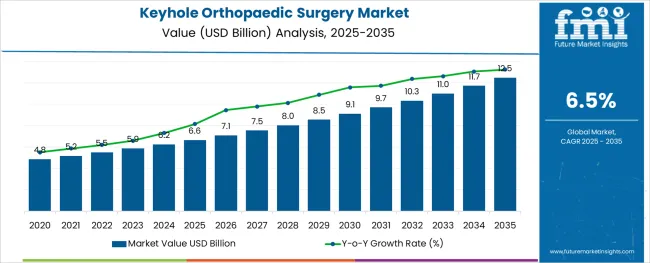
The keyhole orthopaedic surgery market is expanding steadily due to increasing preference for minimally invasive surgical techniques that reduce recovery time and improve patient outcomes. Growing awareness among healthcare providers about the benefits of keyhole procedures has driven demand for specialized surgical equipment. The rise in musculoskeletal disorders caused by aging populations and active lifestyles has increased the need for orthopaedic interventions.
Technological advances in arthroscopic devices have improved surgical precision and broadened the applications of keyhole surgery. Hospitals are investing in modern surgical tools to meet growing patient volumes and enhance procedural efficiency.
The trend toward outpatient surgeries and enhanced recovery protocols further supports market growth. Going forward the market is expected to benefit from continuous innovations in surgical instruments and expanding adoption across healthcare facilities worldwide.
The market is segmented by Product Type and End User and region. By Product Type, the market is divided into Arthroscopes and Arthroscopic Systems, Arthroscopic Shavers, Arthroscopy Implants, and Arthroscopy Radio Frequency Systems and Wands. In terms of End User, the market is classified into Hospitals, Ambulatory Surgical Centers, and Orthopedic Clinics. Regionally, the market is classified into North America, Latin America, Western Europe, Eastern Europe, Balkan & Baltic Countries, Russia & Belarus, Central Asia, East Asia, South Asia & Pacific, and the Middle East & Africa.
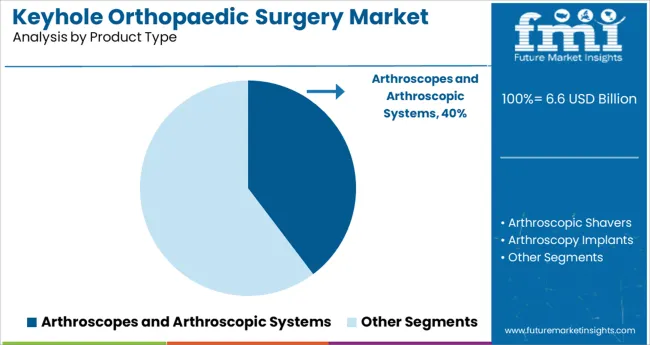
The Arthroscopes and Arthroscopic Systems segment is expected to account for 39.7% of the keyhole orthopaedic surgery market revenue in 2025 holding the leading position among product types. This segment’s growth is supported by its crucial role in enabling minimally invasive joint surgeries through enhanced visualization and maneuverability. Surgeons have increasingly relied on these systems for procedures such as ligament repairs and meniscus surgeries due to their precision and reduced tissue damage.
Advances in imaging technology and ergonomic design have further improved surgical outcomes and usability. The segment also benefits from the rising volume of sports injuries and degenerative joint conditions requiring arthroscopic intervention.
Given its effectiveness and widespread clinical acceptance the Arthroscopes and Arthroscopic Systems segment is projected to maintain its market leadership.
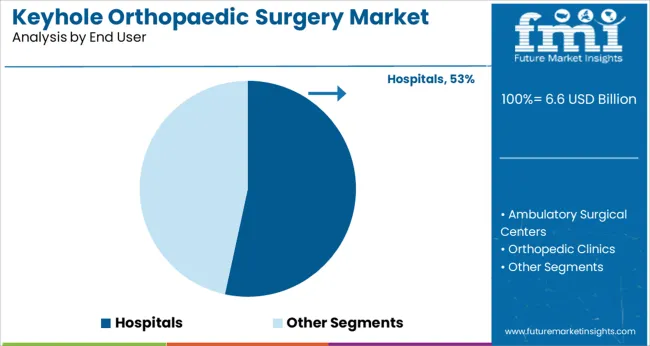
The Hospitals segment is projected to contribute 53.4% of the keyhole orthopaedic surgery market revenue in 2025 establishing it as the primary end user. Growth in this segment has been driven by the concentration of surgical expertise and infrastructure in hospital settings enabling complex keyhole procedures. Hospitals have expanded their orthopaedic departments equipped with advanced arthroscopic technology to accommodate increasing patient demand.
The ability to provide comprehensive perioperative care and postoperative rehabilitation services enhances patient outcomes and supports the adoption of minimally invasive surgery.
Moreover reimbursement frameworks and clinical guidelines have encouraged hospitals to prioritize keyhole surgical techniques for orthopaedic conditions. With ongoing investments in healthcare infrastructure hospitals are expected to remain the dominant end users of keyhole orthopaedic surgery products.
Keyhole orthopaedic surgery is generally performed on an outpatient basis and is used to treat conditions such as damaged or torn cartilage, loose bone fragments, torn ligaments, inflamed joint linings, and scarring within joints among others.
This orthopaedic procedures allows surgeons to examine and repair the damage near joints using pencil-thin surgical equipments which is inserted through small incisions.
Keyhole orthopaedic surgeries are gaining huge popularity, owing to their favorable attributes such as minimally invasive, less loss of blood during procedure, shorter hospital stay post-surgery, faster recovery, and fewer scars among others. This is anticipated to bolster the sales of keyhole orthopaedic surgery in the global market.
Extravagant cost of keyhole orthopaedic surgical procedures, need for expensive surgical equipments & accessories, and postoperative complications related to these procedures are some of the factors hindering the sales in the global market.
Highly skilled and qualified professionals are required to perform such complex minimally invasive surgeries. Hence, lack of such personnel across certain developing and underdeveloped countries is further restraining the growth in the keyhole orthopaedic surgery market.
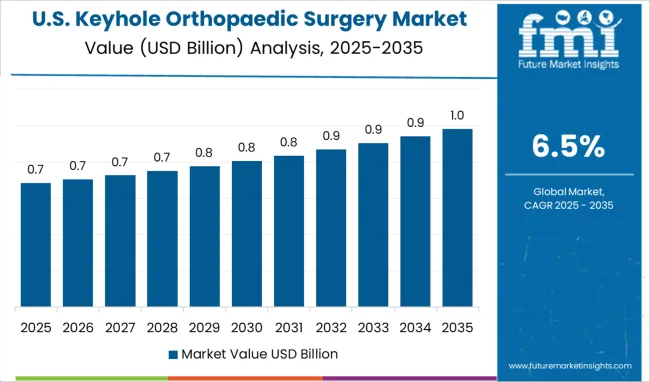
As per a study by Future Market Insights, North America is anticipated to emerge as the most lucrative market for keyhole orthopaedic surgery from 2025 to 2035.
Increasing customer inclinations towards minimally invasive medical processes are accelerating the demand for keyhole orthopaedic surgeries. This, in addition to, growing advancements in technology, leading players in the market are aiming at launching novel tools and assistive equipments to capitalize on the existing opportunities.
For instance, in 2020, Stryker, an American multinational medical technologies corporation announced introducing four visualization tools for keyhole orthopaedic surgery - HipCheck, 1688 AIM 4K Platform, and others, to improve the patient outcomes and surgical efficiency. Such new product launches and development are estimated to augment the growth in the North America market.
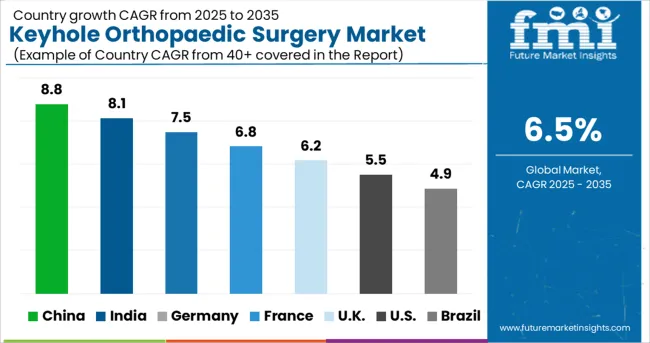
South Asia is projected to account for a significant share in the global keyhole orthopaedic surgery market during the forecast period 2025 to 2035, states FMI.
Due to growing traffic and vehicular fleet, a significant rise in road accidents is being witnessed across South Asia, resulting in the propelling the demand for joint diagnosis and treatment procedures. According to a study by the National Crime Records Bureau, around 354,796 road accident cases were reported across India in the year 2024.
As keyhole orthopaedic surgeries are extensively used for the treatment of ailments such as loose bone fragments, scarring within joints, torn or damaged cartilage, and torn ligaments caused during the accidents, growing number of road accidents is facilitating the sales in South Asia market.
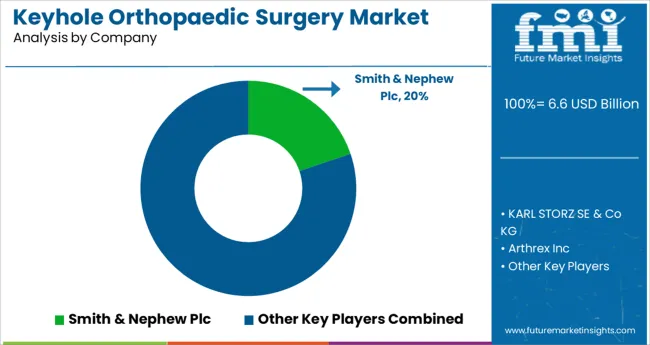
Some of the leading players in the keyhole orthopaedic surgery market are Stryker Corp., Surgical Holdings, Geister Medizintechnik GmbH, STI Laser Industries, Ltd, Zimmer Biomet, DePuy Synthes, Smith & Nephew, DJO Global, Medtronic Spinal, Integra Lifesciences, Globus Medical, NuVasive Inc., Wright Medical.
The market for keyhole orthopaedic surgery is highly competitive, attributed to increasing research and development activities for launching advanced products by key companies.
| Report Attribute | Details |
|---|---|
| Growth Rate | CAGR of 6% to 7% from 2025 to 2035 |
| Base Year for Estimation | 2024 |
| Historical Data | 2020 to 2024 |
| Forecast Period | 2025 to 2035 |
| Quantitative Units | Revenue in million and CAGR from 2025 to 2035 |
| Report Coverage | Revenue Forecast, Volume Forecast, Company Ranking, Competitive Landscape, Growth Factors, Trends and Pricing Analysis |
| Segments Covered | Indication, Application, End User, Region |
| Countries Covered | North America; Latin America; Western Europe; Eastern Europe; APEJ; Japan; Middle East and Africa |
| Key Companies Profiled | Stryker Corp.; Surgical Holdings; Geister Medizintechnik GmbH; STI Laser Industries, Ltd; Zimmer Biomet; DePuy Synthes; Smith & Nephew; DJO Global; Medtronic Spinal; Integra Lifesciences; Globus Medical; NuVasive Inc.; Wright Medical; Others |
| Customization | Available Upon Request |
The global keyhole orthopaedic surgery market is estimated to be valued at USD 6.6 billion in 2025.
It is projected to reach USD 12.5 billion by 2035.
The market is expected to grow at a 6.5% CAGR between 2025 and 2035.
The key product types are arthroscopes and arthroscopic systems, arthroscopic shavers, arthroscopy implants and arthroscopy radio frequency systems and wands.
hospitals segment is expected to dominate with a 53.4% industry share in 2025.






Full Research Suite comprises of:
Market outlook & trends analysis
Interviews & case studies
Strategic recommendations
Vendor profiles & capabilities analysis
5-year forecasts
8 regions and 60+ country-level data splits
Market segment data splits
12 months of continuous data updates
DELIVERED AS:
PDF EXCEL ONLINE
Orthopaedic Imaging Equipment Market Report – Growth & Forecast 2025-2035
Orthopaedic Bone Cement and Casting Material Market Growth – Trends & Forecast 2025 to 2035
Orthopaedic Cushions Market
Polyethylene Orthopaedic Insert Market
Personalized Orthopaedic Implant Market
Biosurgery Equipment Market Size and Share Forecast Outlook 2025 to 2035
Post-Surgery Skin Repair Market Analysis - Size and Share Forecast Outlook 2025 to 2035
Neurosurgery Surgical Power Tools Market Analysis – Growth & Forecast 2022-2032
Electrosurgery Accessories Market Size and Share Forecast Outlook 2025 to 2035
Guided Surgery Kits Market Size, Growth, and Forecast for 2025 to 2035
Electrosurgery Devices Market Overview - Trends & Growth Forecast 2025 to 2035
Electrosurgery Generators Market Analysis - Size, Share, and Forecast 2025 to 2035
General Surgery Devices Market Insights – Demand and Growth Forecast 2025 to 2035
Cardiac Surgery Devices Market Analysis – Trends & Forecast 2024-2034
Cosmetic Surgery Products Market Analysis - Size, Share, and Forecast Outlook 2025 to 2035
Cataract Surgery Device Market Analysis – Growth & Forecast 2024-2034
Bariatric Surgery Device Market Forecast and Outlook 2025 to 2035
5G Remote Surgery System Market Analysis - Size, Share, and Forecast Outlook 2025 to 2035
Refractive Surgery Device Market Size and Share Forecast Outlook 2025 to 2035
Lung Cancer Surgery Market - Size, Share, and Forecast 2025 to 2035

Thank you!
You will receive an email from our Business Development Manager. Please be sure to check your SPAM/JUNK folder too.
Chat With
MaRIA